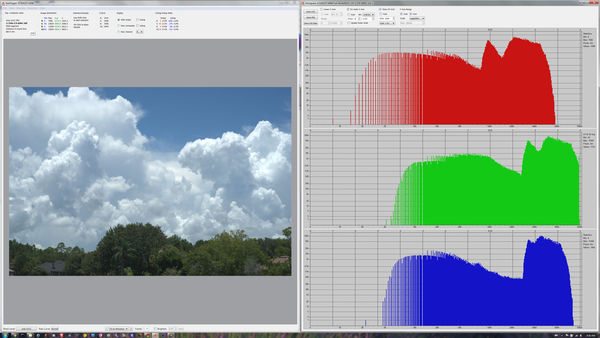Check out Black and White Photography section of our forum.
Something I Learned About Blinkies
Aug 16, 2020 18:07:41 #
Ysarex wrote:
So I do a similar informal test with my Fuji XT-4 and the blinkies seem to go off as soon as one channel clips. I suspect it's just going to be variable with different brands. I haven't seen an RP yet (eventually one will walk into class) but sounds like you have live RGB histograms before you take the photo. My Fujis do that which I really like -- I get nice big L, R, G, B histograms before I take the photo. My Nikon Z7 doesn't do that. All it has is a stinkin' little luminosity histogram.
You can set the evf to display either the luminosity one or the set of 3 separate ones, but not both together. You have to squint a little to see it climb the right side, but it's doable.
Aug 16, 2020 18:49:55 #
Ysarex wrote:
... My Nikon Z7 doesn't do that. All it has is a stinkin' little luminosity histogram.
It has the RGB histograms that you could always see on the DSLRs after the fact including the features described in the video.
But it has Zebra warnings which are more useful - all you really need.
Aug 16, 2020 19:05:36 #
Ysarex
Loc: St. Louis
selmslie wrote:
It has the RGB histograms that you could always see on the DSLRs after the fact including the features described in the video.
Like I said; "sounds like you have live RGB histograms before you take the photo." It doesn't do that.
Check out Underwater Photography Forum section of our forum.
Aug 16, 2020 19:13:03 #
Ysarex wrote:
Like I said; "sounds like you have live RGB histograms before you take the photo." It doesn't do that.
I said “after the fact”. That’s what we get with a DSLR today.
Aug 16, 2020 22:42:17 #
selmslie wrote:
I said “after the fact”. That’s what we get with a DSLR today.
My Olympus can be set to show this in the EVF. It is live before taking the pic.
Aug 17, 2020 01:27:20 #
Ysarex
Loc: St. Louis
selmslie wrote:
I said “after the fact”. That’s what we get with a DSLR today.
Duh. My Z7 isn't a DSLR.
Aug 17, 2020 05:21:54 #
Check out Film Photography section of our forum.
Aug 17, 2020 08:16:04 #
Aug 17, 2020 09:15:08 #
cactuspic
Loc: Dallas, TX
There are specific processes for which you don't want to expose to the right or to maximize the exposure. In particular, you don't want to do it while focus stacking. In focus stacking, you want to leave a little headroom on your highs. The reason has to do with the out of focus highlight and the fact that when you take a frame where those highlight are in focus, they will register much brighter.
For an example, when a test chart is in focus, the contrast between white and black is at it's highest and the whites are their whitest. As it becomes more defocused, a blending between the black and white occurs and a graying takes place. If its totally out of focus the chart will become a uniform shade of gray. a real world example of this occurence is when we shoot wide open to knock out the detail in the background, we are blending the light in the background so that the highs and lows are no longer distinct.
Although there is a small leeway for exposure differences between individual images in the stack, the software works best when the same exposure is used for the entire stack. As it is likely that there are highlights that will be brighter when in focus than in the first image of the stack, you want to set your exposure before the blinkies. You don't want to expose to the right.
I realize theat focus stacking is a bit of a niche. But as more and more cameras have focus stacking as a feature, it's usage is growing. Therefor, the general rules that we use for exposure (blinkies, ETTR) may have to be modified. I don't recall any such caveat in all the posts on exposure.
For an example, when a test chart is in focus, the contrast between white and black is at it's highest and the whites are their whitest. As it becomes more defocused, a blending between the black and white occurs and a graying takes place. If its totally out of focus the chart will become a uniform shade of gray. a real world example of this occurence is when we shoot wide open to knock out the detail in the background, we are blending the light in the background so that the highs and lows are no longer distinct.
Although there is a small leeway for exposure differences between individual images in the stack, the software works best when the same exposure is used for the entire stack. As it is likely that there are highlights that will be brighter when in focus than in the first image of the stack, you want to set your exposure before the blinkies. You don't want to expose to the right.
I realize theat focus stacking is a bit of a niche. But as more and more cameras have focus stacking as a feature, it's usage is growing. Therefor, the general rules that we use for exposure (blinkies, ETTR) may have to be modified. I don't recall any such caveat in all the posts on exposure.
Aug 17, 2020 09:23:44 #
bleirer wrote:
I did an informal test with my canon RP. Using the... (show quote)
Even more intriguing, I found a picture on my tablet of large rgb dots in a pattern, each dot only red or green or blue each maybe a half inch. I defocused the lens and took some shots, looking for blinkies after each shot. No matter how much to the right I pushed, I never got a blinkie, even though all 3 individually were well off the right side of the histogram.
I then found an rgb gradient, basically a rainbow I guess, and also never got a blinkie.
So I have to assume the same pixel in the jpeg has to have at least 2 colors blown to make a blinkie, since in this case all 3 colors were blown in the overall image, but never in the same pixel at the same time?
Aug 17, 2020 09:31:00 #
cactuspic
Loc: Dallas, TX
As someone who shoot's in live view often, the statement that you don't have a live histogram with a DSLR is incorrect. For years, I have been able to use a live histogram on all of my product shots, all of my landscapes, and all of my focus stacked images. For the past 10 years, I have shot exclusively with Canon bodies, so I can't speak as to Nikon's or Sony's use of histograms in their dslr bodies. But I know that on many Canon DSLRs you do get a live histogram. The statement should be modified to say that you don't get a live histogram in the optical viewfinder.
Check out Panorama section of our forum.
Aug 17, 2020 09:34:57 #
cactuspic wrote:
There are specific processes for which you don't w... (show quote)
That is interesting. On my RP in the focus stack menu there is a Check box to automatically do exposure smoothing, but it instructs me to uncheck it for certain lenses.
Aug 17, 2020 09:53:39 #
bleirer wrote:
Even more intriguing, I found a picture on my tabl... (show quote)
Good observation.
In most of the RawDigger cases I tested I have taken the exposure where the highlights get blown to the point where 1/3 stop less exposure would have not blown them.
Here is an example of an exposure with blown highlights. The one just prior to it was OK (LV 15.33). But for this exposure a total o about 13,000 pixels got blown somewhere in the clouds because of going 1/3 stop too far. But even 13,000 blown pixels does not mean the image is ruined.
So it depends on the nature of the highlights being blown. Here the bright clouds have pretty smooth tonality so when the highlights are blown the pixels have a lot of company nearby.
But specular highlights are a different matter. Single pixels might be blown in any of the three colors but RawDigger will probably report only a small number of them, maybe fewer that 100 out of 24MP.
Then again, we should not worry about specular highlights.
Aug 17, 2020 10:07:22 #
cactuspic wrote:
There are specific processes for which you don't w... (show quote)
This was really helpful for me. Thanks!
Aug 17, 2020 10:35:09 #
If you want to reply, then register here. Registration is free and your account is created instantly, so you can post right away.







